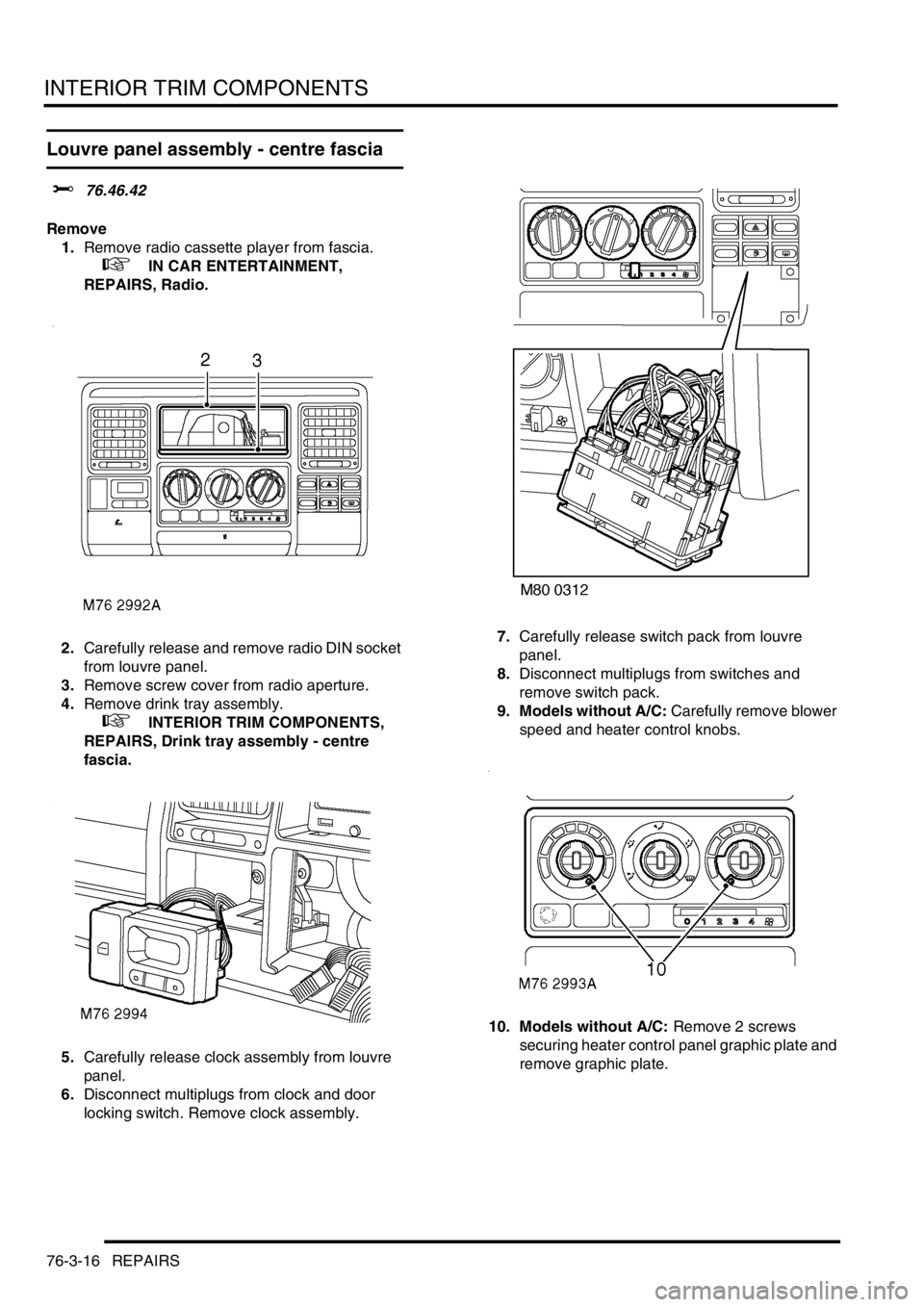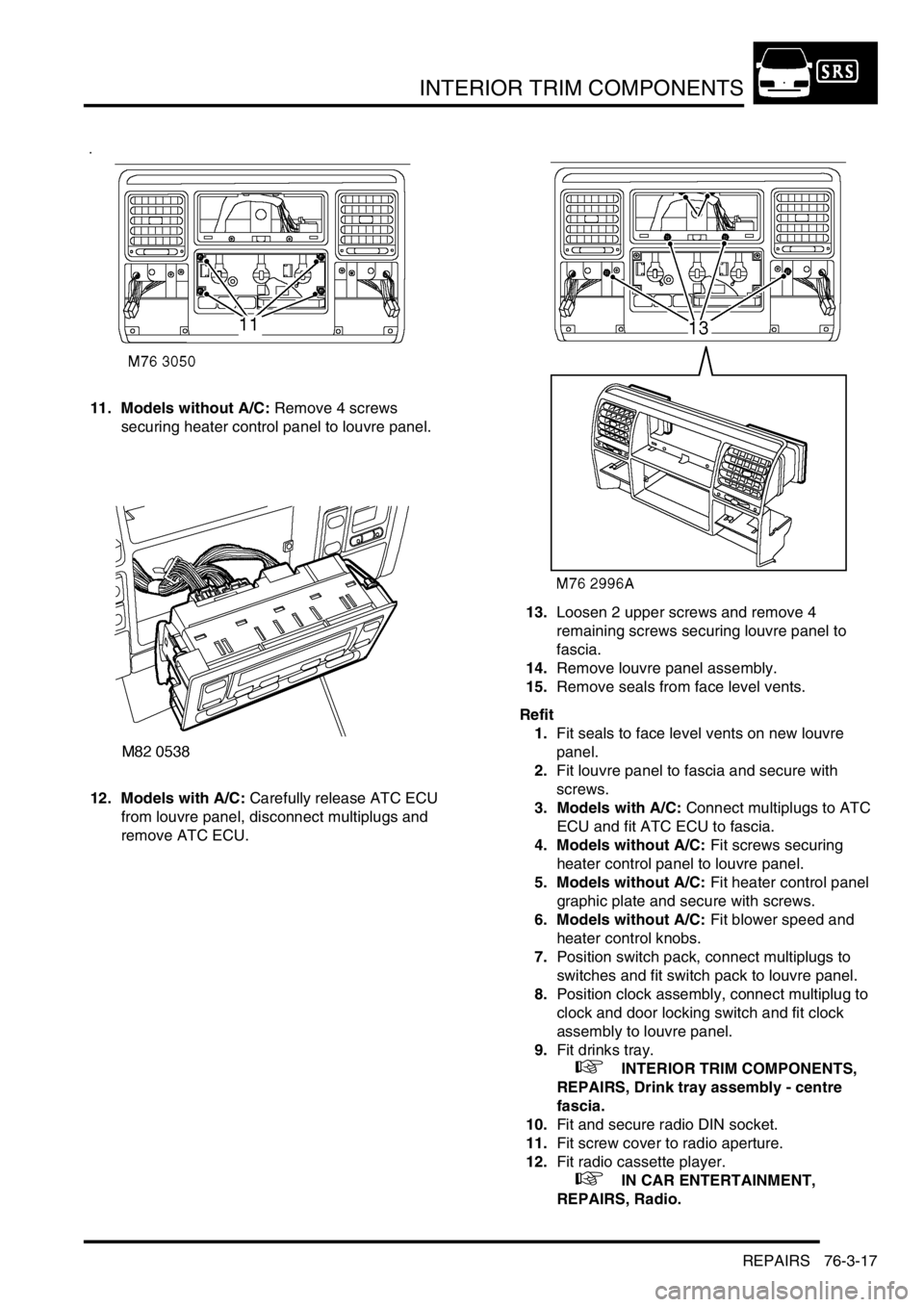heater LAND ROVER DISCOVERY 1999 Owner's Manual
[x] Cancel search | Manufacturer: LAND ROVER, Model Year: 1999, Model line: DISCOVERY, Model: LAND ROVER DISCOVERY 1999Pages: 1529, PDF Size: 34.8 MB
Page 423 of 1529

COOLING SYSTEM - V8
26-2-8 DESCRIPTION AND OPERATION
Coolant pump
1Pulley flange
2Body
3Impeller4Gallery
5Inlet connection
The coolant pump is attached to the front of the cylinder block with nine bolts and sealed between the pump housing
and the cylinder block with a gasket. The pump comprises a shaft which passes through an alloy housing. The outer
end of the shaft has a flange which allows for the attachment of the pump drive pulley which is secured with three
bolts. The drive pulley is driven by the grooved auxiliary drive belt and rotates at the same speed as the crankshaft.
The inner end of the shaft is fitted with an impeller which draws coolant from the thermostat housing and circulates it
through the galleries in the cylinder block and through the heater matrix.
The shaft is supported on bearings in the housing which are packed with grease and sealed for life. A seal is
positioned in the housing to further protect the bearings from the ingress of coolant. The seal is manufactured from a
synthetic material which will allow for expansion of the casing when hot coolant is present.
The cast alloy housing has a hose connection which provides the attachment for the coolant pump feed hose. The
cast housing connects with galleries in the cylinder block and distributes coolant from the pump impeller into the
galleries and water jackets.
Page 425 of 1529

COOLING SYSTEM - V8
26-2-10 DESCRIPTION AND OPERATION
Operation
Coolant flow - Engine warm up
Refer to illustration.
+ COOLING SYSTEM - V8, DESCRIPTION AND OPERATION, Cooling system coolant flow.
During warm-up the coolant pump moves fluid through the cylinder block and it emerges from the inlet manifold outlet
pipe. From the outlet pipe, the warm coolant flow is prevented from flowing through the radiator because the
thermostat is closed. The coolant is directed into the heater circuit.
Some coolant from the by-pass pipe can pass through small sensing holes in the flow valve. The warm coolant enters
a tube in the thermostat housing and surrounds 90% of the thermostat sensitive area. Cold coolant returning from the
radiator bottom hose conducts through 10% of the thermostat sensitive area. In cold ambient temperatures the engine
temperature can be raised by up to 10°C (50°F) to compensate for the heat loss of the 10% exposure to the cold
coolant returning from the radiator bottom hose.
At engine idle speed, the by-pass valve is closed only allowing the small flow through the sensing holes. As the engine
speed increases above idle, the greater flow and pressure from the pump overcomes the light spring and opens the
by-pass flow valve. The flow valve opens to meet the engines cooling needs at higher engine speeds and prevents
excess pressure in the system. With the thermostat closed, maximum flow is directed through the heater circuit.
The heater matrix acts as a heat exchanger reducing coolant temperature as it passes through the matrix. Coolant
emerges from the matrix and flows into the coolant pump feed pipe and recirculated around the heater circuit. In this
condition the cooling system is operating at maximum heater performance.
Coolant flow - Engine hot
As the coolant temperature increases the thermostat opens. This allows some coolant from the outlet housing to flow
through the top hose and into the radiator to be cooled. The hot coolant flows from the left tank in the radiator, along
the tubes to the right tank. The air flowing through the fins between the tubes cools the coolant as it passes through
the radiator.
A controlled flow of the lower temperature coolant is drawn by the pump and blended with hot coolant from the by-
pass and the heater return pipes in the pump feed pipe. The pump then passes this coolant into the cylinder block to
cool the cylinders.
Page 438 of 1529

MANIFOLDS AND EXHAUST SYSTEMS - V8
DESCRIPTION AND OPERATION 30-2-3
1Upper manifold
2Bolt 5 off
3Bolt 1 off
4Gasket
5IAC Valve
6IAC valve hose 2 off
7Bolt 4 off
8Bolt 4 off
9Schraeder valve
10Injector 8 off
11Retaining clip 8 off
12Bolt 12 off
13Bolt 2 off
14Clamp 2 off
15Seal 2 off
16Lower manifold/engine gasket
17Coolant pipe18Bolt 3 off
19Bolt
20Heater return pipe
21Pipe connection
22Lower manifold
23Gasket
24Hose clip 2 off
25Throttle housing coolant hose
26Fuel rail
27Throttle housing
28Gasket
29Bolt 4 off
30Plenum
31Rocker cover breather hose connection
32Brake servo vacuum pipe connection
33Hose clip 4 off
Page 440 of 1529

MANIFOLDS AND EXHAUST SYSTEMS - V8
DESCRIPTION AND OPERATION 30-2-5
Description
General
The inlet manifold on the V8 engine is located on the top of the engine, between the cylinders. The manifold directs
intake air into the cylinders. The intake air is mixed with fuel delivered by the injectors prior to ignition in the cylinders.
The inlet manifold comprises three separate aluminium castings.
Two exhaust manifolds are used, one for each bank of four cylinders. Each exhaust manifold allows combustion
gases from the cylinders to leave the engine and directs them into the exhaust system.
The exhaust system is connected to each exhaust manifold and merges into one pipe midway along the underside of
the vehicle. A catalytic converter (where fitted) is located in the front pipe from each manifold. A silencer is installed
midway along the system and a second tail silencer is located at the rear of the vehicle.
Inlet manifold
The inlet manifold comprises three aluminium castings; a lower manifold, an upper manifold and a plenum. The inlet
manifold is located on the top of the engine and feeds air into the cylinders.
Lower manifold
The lower manifold is a one piece machined aluminium casting which locates in the vee on the top of the engine and
is secured to each cylinder head with six bolts per head. A one piece coated metal gasket seals the lower manifold to
each cylinder head and also serves as a cover for the cylinder block.
Eight injectors are fitted into the lower manifold, four on each side. Each injector is sealed in the manifold with O-ring
seals and retained in position by the fuel rails. A fuel rail is attached to each side of the manifold and secured with two
bolts.
Eight air intake ports are cast and machined on the top of the manifold, each port directing intake air into one cylinder.
These ports mate with matching ports in the upper manifold and are sealed with a coated metal gasket between the
two manifolds.
A cavity at the front of the manifold collects coolant flow from the engine. A coolant outlet pipe is sealed and attached
to the front of the manifold and provides for coolant to flow through the cavity in the casting to the radiator top hose.
A smaller port in the manifold also allows coolant to flow from the cavity to the heater matrix. The lower manifold also
locates the Engine Coolant Temperature (ECT) sensor in a port in the front of the manifold.
Upper manifold
The upper manifold is a one piece machined aluminium casting. The manifold has eight ports on its lower face which
mate with the eight ports on the lower manifold. The joint between the upper and lower manifolds is sealed with a
coated metal gasket and secured with six bolts.
The manifold divides from the eight ports into eight branches, four on each side. Each set of four branches merge into
one gallery on each side of the manifold. Each gallery has an opening at its forward end which mates with the intake
plenum.
The upper manifold provides attachment for the Idle Air Control (IAC) valve and for brackets which retain pipes, plug
leads and throttle cables.
Inlet plenum
The plenum is mounted transversely on the front of the upper manifold. The plenum divides into two galleries which
connect with the galleries on the upper manifold. The plenum is secured to the upper manifold with four bolts and
sealed with a coated metal gasket.
The plenum provides attachment for the throttle housing, which is secured with four bolts and sealed with a coated
metal gasket. The plenum also has vacuum connections for brake servo, rocker cover breather and fuel vapour from
the charcoal canister. A port on the top of the plenum connects via a hose to the IAC valve.
Page 954 of 1529

EXTERIOR FITTINGS
REPAIRS 76-2-7
Panel - underbelly
$% 76.10.50
Remove
1.Raise front of vehicle, support underbody and
lower front axle
WARNING: Do not work on or under a
vehicle supported only by a jack. Always
support the vehicle on safety stands.
2.Remove nut securing drag link to drop arm.
3.Using tool LRT-57-036 break taper joint and
release drag link from drop arm.
4.Remove nut and bolt securing steering damper
to chassis and remove damper.
5.Remove 7 screws securing underbelly panel.
6.Remove underbelly panel.
7.Remove 7 studs securing sound deadening to
underbelly panel.
8.Remove sound deadening.
Refit
1.Position sound deadening to underbelly panel
and secure with studs.
2.Fit underbelly panel and secure with screws.
3.Position steering damper, fit nut and bolt and
tighten to 125 Nm (92 lbf.ft)
4.Fit drag link to drop arm and tighten nut to 80
Nm (59 lbf.ft).
5.Lower front of vehicle.
Mirror - exterior - electric
$% 76.10.57
Remove
1.Release cheater panel from front door.
2.Remove anti-rattle foam pad from front door.
3.Release mirror multiplug from mounting plate.
4.Disconnect multiplug from mirror.
5.Remove 3 bolts securing mirror to door.
6.Remove mirror and collect mounting plate.
Refit
1.Fit mirror and mounting plate to door.
2.Fit bolts securing mirror to door and tighten to
4 Nm (3 lbf.ft).
3.Connect multiplug to mirror.
4.Secure multiplug to mounting plate.
5.Fit anti-rattle foam pad to front door.
6.Secure cheater panel to front door.
Page 976 of 1529

INTERIOR TRIM COMPONENTS
REPAIRS 76-3-11
13.Remove fascia access panel.
+ INTERIOR TRIM COMPONENTS,
REPAIRS, Panel - fascia access - driver's
side.
14.Remove 4 nuts securing fascia to steering
column bracket.
15.Disconnect 3 multiplugs connecting main body
harness to fascia harness.
16.Disconnect fascia harness multiplug from fuse
box.
17.Remove 4 bolts securing glove box and remove
glove box.18. Models with A/C: Disconnect multiplug from
heater controls.
19. Models without A/C: Release temperature
and air distribution control outer cables from
clips on heater casing and disconnect inner
cables from levers.
Page 977 of 1529

INTERIOR TRIM COMPONENTS
76-3-12 REPAIRS
20.Separate blue section from ICE multiplug.
21.Release coaxial cables from fascia panel.
22.Disconnect multiplug from passenger air bag.
23.Disconnect multiplug from blower motor.
24.Working through glove box aperture remove 2
bolts, or 4 bolts if passenger airbag module is
fitted, securing fascia to body.25.Remove 4 bolts securing lower edge of fascia
to mounting brackets on transmission tunnel.
26.Remove 4 bolts securing lower edge of fascia
to brackets on 'A' post.
27.With assistance carefully remove fascia from
vehicle.
28.If renewing fascia, transfer components to new
fascia as necessary.
Refit
1.With assistance carefully fit fascia and tighten
bolts securing lower edge of fascia to 26 Nm
(19 lbf.ft).
2.Tighten bolts securing fascia to body to 26 Nm
(19 lbf.ft).
3.Fit nuts securingfascia to steering column
bracket to 11 Nm (8 lbf.ft).
4.Secure coaxial cables to fascia and secure blue
multiplug to main ICE multiplug.
5. Models with A/C: Connect heater control
multiplug.
6. Models without A/C: Connect temperature
and air distribution inner cables to heater
control levers. Set temperature control knobs to
fully hot, distribution knob to demist position
and, with flap levers fully closed, secure outer
cables to clips on heater casing.
7.Connect multiplugs to blower motor and
passenger air bag (where fitted).
8.Fit glove box and secure with bolts.
9.Connect fascia harness multiplugs to main
harness and fuse box.
10.Position instrument pack and connect
multiplugs.
Page 981 of 1529

INTERIOR TRIM COMPONENTS
76-3-16 REPAIRS
Louvre panel assembly - centre fascia
$% 76.46.42
Remove
1.Remove radio cassette player from fascia.
+ IN CAR ENTERTAINMENT,
REPAIRS, Radio.
2.Carefully release and remove radio DIN socket
from louvre panel.
3.Remove screw cover from radio aperture.
4.Remove drink tray assembly.
+ INTERIOR TRIM COMPONENTS,
REPAIRS, Drink tray assembly - centre
fascia.
5.Carefully release clock assembly from louvre
panel.
6.Disconnect multiplugs from clock and door
locking switch. Remove clock assembly.7.Carefully release switch pack from louvre
panel.
8.Disconnect multiplugs from switches and
remove switch pack.
9. Models without A/C: Carefully remove blower
speed and heater control knobs.
10. Models without A/C: Remove 2 screws
securing heater control panel graphic plate and
remove graphic plate.
Page 982 of 1529

INTERIOR TRIM COMPONENTS
REPAIRS 76-3-17
11. Models without A/C: Remove 4 screws
securing heater control panel to louvre panel.
12. Models with A/C: Carefully release ATC ECU
from louvre panel, disconnect multiplugs and
remove ATC ECU.13.Loosen 2 upper screws and remove 4
remaining screws securing louvre panel to
fascia.
14.Remove louvre panel assembly.
15.Remove seals from face level vents.
Refit
1.Fit seals to face level vents on new louvre
panel.
2.Fit louvre panel to fascia and secure with
screws.
3. Models with A/C: Connect multiplugs to ATC
ECU and fit ATC ECU to fascia.
4. Models without A/C: Fit screws securing
heater control panel to louvre panel.
5. Models without A/C: Fit heater control panel
graphic plate and secure with screws.
6. Models without A/C: Fit blower speed and
heater control knobs.
7.Position switch pack, connect multiplugs to
switches and fit switch pack to louvre panel.
8.Position clock assembly, connect multiplug to
clock and door locking switch and fit clock
assembly to louvre panel.
9.Fit drinks tray.
+ INTERIOR TRIM COMPONENTS,
REPAIRS, Drink tray assembly - centre
fascia.
10.Fit and secure radio DIN socket.
11.Fit screw cover to radio aperture.
12.Fit radio cassette player.
+ IN CAR ENTERTAINMENT,
REPAIRS, Radio.
Page 990 of 1529

SCREENS
REPAIRS 76-4-1
SCREENS REPAIRS
Glass/sealing rubber - tail door
$% 76.31.22
Remove
1.Remove spare wheel from rear door.
2.Remove centre high mounted stop lamp.
+ LIGHTING, REPAIRS, Lamp - stop -
centre high mounted (CHMSL).
3.Pull the rear wiper arm away from the glass.
4.Disconnect leads from rear window heater.
5.Ease glass sealing rubber from tail door flange
and with assistance, from inside push the glass
and sealing rubber out.
6.Remove sealing rubber from glass. Refit
1.Thoroughly clean the tail door glass mounting
flange.
2.Clean glass and fit sealing rubber. Ensure
sealing rubber is fully located onto glass.
3.Fit a draw cord into the outside groove of the
sealing rubber with cord ends situated on top
corner of bend at bottom of glass.
4.To aid assembly, lubricate the tail door glass
mounting flange with liquid soap.
5.Position the assembled glass and rubber to
outside of flange.
6.With assistance from second operator pushing
glass into door, hold one end of cord and pull
the other end carefully around the aperture,
easing the rubber seal over the flange.
7.Connect leads to rear window heater.
8.Fit centre high mounted stop lamp.
+ LIGHTING, REPAIRS, Lamp - stop -
centre high mounted (CHMSL).
9.Fit rear wiper onto glass.
10.Fit spare wheel.